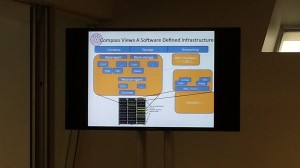Towards a Self-Driving Infrastructure
and also is independent of Openstack. The code has been opensourced and is in a stable state.
Experience with OpenStack in Telco Infrastructure Transformation
With the wide spread adoption of NFV among the telcos, day 1 had an interesting panel discussion between the cloud vendors and the telco players which included Verizon, AT&T, Vodafone, Huawei & Mirantis. From a cloud vendor perspective, Mirantis had an opinion that the virual infrastructure manager like NFV enhances the agility of a carrier and as a follow up quick survey of the audience, many attendees were aware of NFV and its advantages. Telecom companies were more concerned with the service assurance and the impact of API change that sets in due to frequent update of the open source project like NFV. However both the parties agreed to open source model being the right way forward for standardization especially in the telecom domain.
Load Balancing as a Service v2.0 – Juno and Beyond
LBaaS extension allows the tenants load-balance their VMs traffic. For the Juno release cloud providers such as Rackspace, HP, etc. have partnered with the community and load balancer vendors to redefine the load balancing as a service APIs (API v2.0) to address tenant needs. Load Balancing as a Service also enables adjusting of application resources to changing demands by scaling in and scaling out of the application resources.

